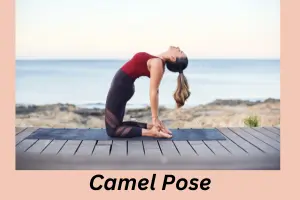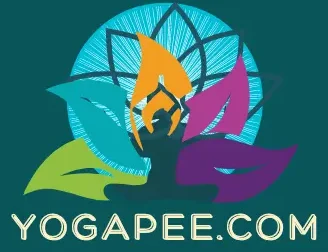Introduction
Ustrasana, commonly known as Camel Pose, is a deep backbend that opens the chest, stretches the front of the body, and strengthens the back muscles.
The Sanskrit word “Ustra” means camel, and “asana” means pose. This posture resembles the curved shape of a camel’s hump, and it is a heart-opening asana that improves flexibility and posture.

Ustrasana is known for its ability to release tension in the body, boost energy, and stimulate the respiratory and circulatory systems.
Practicing this asana regularly helps build both physical and mental resilience, as it encourages practitioners to expand their chest and open themselves to new possibilities, both physically and emotionally.
Steps to Perform Ustrasana (Camel Yoga Pose)
- Begin in a Kneeling Position: Start by kneeling on your yoga mat, with your knees hip-width apart and the tops of your feet resting on the floor. Ensure that your thighs are perpendicular to the floor and your spine is straight.
- Place Your Hands on Your Lower Back: Bring your hands to your lower back or sacrum, with your fingers pointing downward. Use your hands to support your lower back as you prepare to arch backward.
- Lift Your Chest: Inhale deeply, and as you exhale, begin to press your hips forward while lifting your chest upward. Focus on lengthening your spine as you arch backward, keeping your hips aligned over your knees.
- Reach for Your Heels: Once you feel comfortable in the backbend, reach your right hand toward your right heel and your left hand toward your left heel. If you cannot reach your heels, keep your hands on your lower back for support.
- Open Your Chest and Throat: Once your hands are on your heels, open your chest fully and drop your head back, gazing upward. Allow your shoulder blades to squeeze together, expanding your chest and creating a deep stretch through the front of your body.
- Engage Your Thighs and Core: As you hold the pose, engage your thighs and core muscles to protect your lower back. Keep pressing your hips forward to maintain alignment and prevent any strain in the lower spine.
- Breathe Deeply: Stay in Ustrasana for 5-10 breaths, focusing on deep inhalations and exhalations. With each inhale, feel your chest expanding, and with each exhale, relax deeper into the stretch.
- Exit the Pose Carefully: To release the pose, bring your hands back to your lower back for support, and slowly lift your torso back to an upright position. Rest in a seated position or Balasana to counteract the deep backbend.
Benefits of Ustrasana (Camel Yoga Pose)
- Improves Flexibility: Ustrasana deeply stretches the front of the body, including the chest, abdomen, quadriceps and hip flexors. This improves overall flexibility, particularly in the spine and shoulders.
- Strengthens the Back and Core: By engaging the muscles along the spine, Ustrasana strengthens the lower back, middle back, and core muscles. This helps improve posture and stability in everyday activities.
- Opens the Chest and Heart: Ustrasana is a powerful heart-opener, which helps to increase lung capacity, improve breathing, and stimulate the respiratory system. It is particularly beneficial for individuals with asthma or other respiratory conditions.
- Stimulates the Digestive Organs: The backbend in Ustrasana creates a gentle compression of the abdominal area, stimulating the digestive organs and promoting better digestion and detoxification.
- Boosts Circulation: This pose increases blood circulation throughout the body, especially to the brain and heart, which helps improve focus, energy, and vitality.
- Relieves Lower Back Pain: While strengthening the back, Ustrasana also stretches and decompresses the spine, which can help alleviate lower back pain and stiffness.
- Enhances Emotional Well-Being: Ustrasana opens the heart center, encouraging emotional release and relieving feelings of stress, anxiety, and depression. This pose is often associated with feelings of vulnerability, helping practitioners overcome emotional blockages.
- Balances Hormones: The deep stretch of the throat and neck in Ustrasana stimulates the thyroid and parathyroid glands, which play a key role in regulating metabolism and hormone levels in the body.
Precautions and Contraindications of Ustrasana (Camel Yoga Pose)
- Back or Neck Injuries: Individuals with neck, back, or spinal issues should avoid Ustrasana or practice it under the guidance of an experienced instructor. If there is any discomfort in the neck or back, it is advisable to modify the pose by not dropping the head back or using blocks for support.
- High or Low Blood Pressure: Ustrasana may affect blood flow and circulation, especially when the head is tilted backward. People with high or low blood pressure should approach this pose with caution and avoid holding it for too long.
- Pregnancy: Pregnant women, especially in the second and third trimesters, should avoid Ustrasana due to the pressure it places on the abdomen and lower back. Gentle backbend modifications with props are preferable.
- Migraine or Vertigo: Practitioners who experience migraines, dizziness, or vertigo should avoid this pose, as the backward tilt of the head can exacerbate these conditions.
- Spondylitis or Hernia: People with cervical spondylitis, hernias, or other spinal conditions should avoid deep backbends like Ustrasana, as the pose can worsen symptoms. Always consult with a healthcare provider if there is any concern about spinal health.
- Avoid Forcing the Backbend: It is essential to ease into Ustrasana gradually and avoid forcing the body into a deep backbend. If the lower back feels compressed or strained, it is better to reduce the depth of the backbend and focus on proper alignment.
- Using Props for Support: Beginners or individuals with limited flexibility may use yoga blocks under their hands to help stabilize the body. This modification allows for a safer, more comfortable experience in the pose.
Conclusion
- Camel Yoga Pose is a profound heart-opening yoga posture that provides numerous physical, mental, and emotional benefits.
- It stretches the entire front of the body, strengthens the back muscles, and improves flexibility in the spine, shoulders, and chest.
- This Pose can be especially transformative for those looking to release tension, improve posture and enhance respiratory function.
- However, as with any deep backbend, it is essential to approach the pose with mindfulness and care, respecting the body’s limitations.
- This pose also has significant emotional benefits, helping practitioners open their hearts and release built-up stress and anxiety.
- It encourages a sense of openness and vulnerability, fostering emotional healing and personal growth.
- For those who practice regularly and mindfully, Camel Yoga Pose can be an empowering asana that strengthens both body and mind, cultivating inner balance and harmony.
